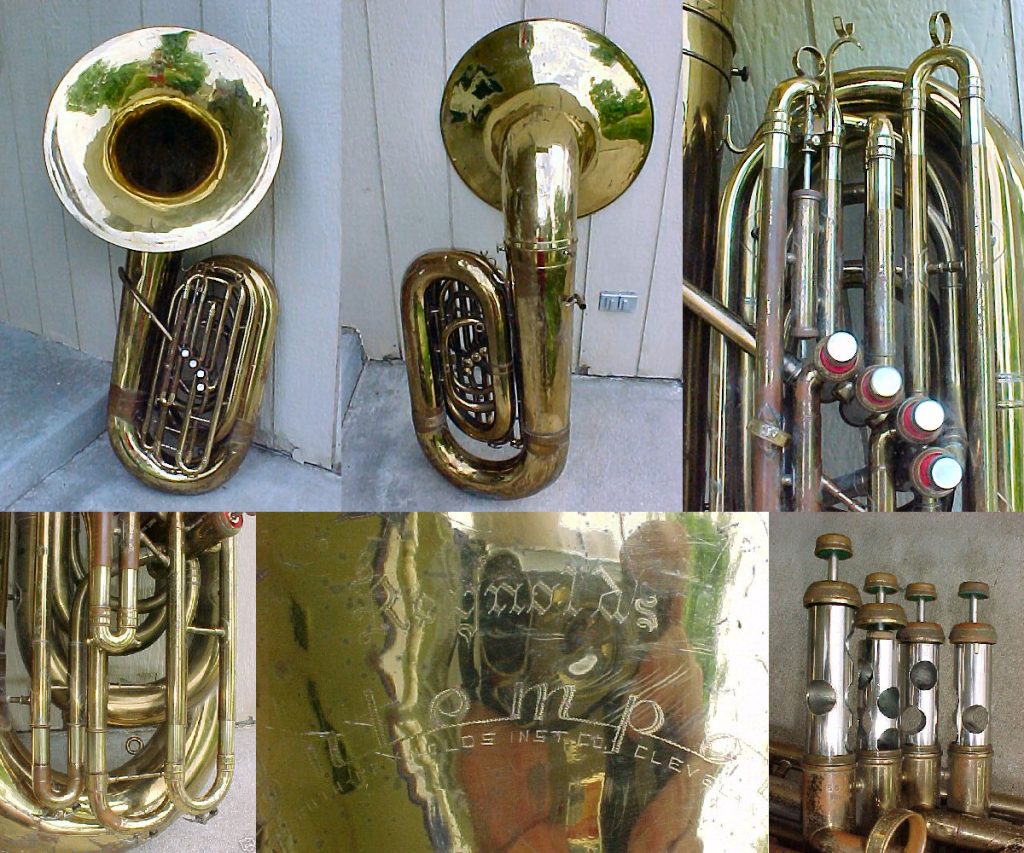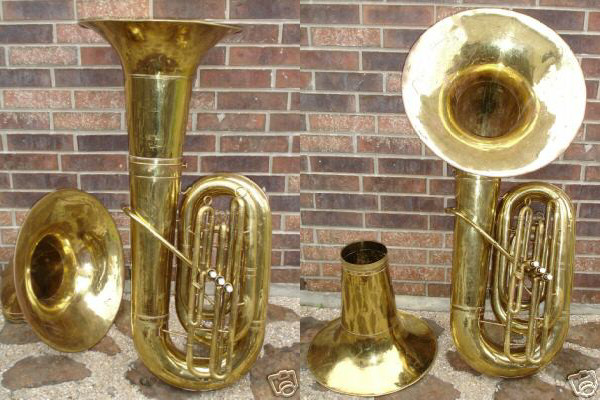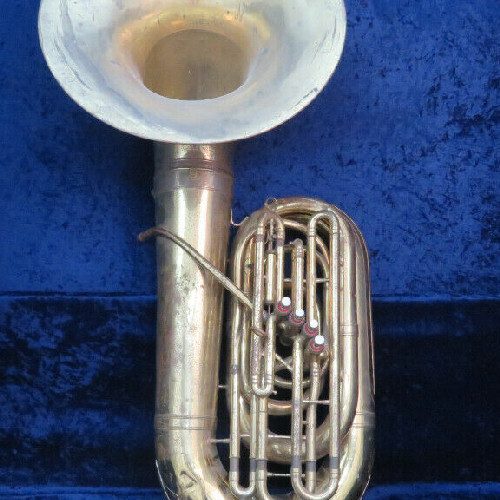
While Reynolds made sousaphones from the earliest days, full-size basses seem to have created later, in the mid-1940s. Both Regent and Reynolds models entered the market around the end of World War 2—it's yet undetermined if basses were made for the Army service bands. Most service band photos from the time show sousaphones as the bass voice instrument.
1936-1949
F.A. Reynolds (Cleveland, Ohio)
The earliest documented example of a Recording Bass from the Reynolds factory is from c. 1944, a Regent model—the earliest Reynolds model is from approximately four years later.
Model 170
Reynolds BB♭ Symphony Bass
Bore: TBD
Bell: TBD adjustable, detachable front-facing bell
Valves: three side-action piston valves; optional fourth valve
Materials: brass with nickel-silver valve caps, bracing and trim
Finish: polished brass with clear lacquer finish; silverplated finish with bright bell or gold bell
Note: photos used with permission from eBay seller: ford-c600
Model 180
Reynolds E♭ Symphony Bass
Bore: TBD
Bell: TBD adjustable, detachable front-facing bell
Valves: three side-action piston valves
Materials: brass with nickel-silver valve caps, bracing and trim
Finish: polished brass with clear lacquer finish; silverplated finish with bright bell or gold bell
Note: photos used with permission from eBay seller: 2005marinich
Here are the real "guts" of the band and, yes, in many cases the orchestra. Reynolds designs its baritones and recording basses to entirely fulfill that dual purpose. Reynolds builds into these deep-throated instruments with unerring purpose a full, rich luscious tone ... in the baritone a remarkable similarity to the human voice ... and in the recording bass a deep and gusty likeness to—yes—the greatest of the vocal basses.
The Regent instruments were made by Ohio Band Instrument Co., a subsidiary of F.A. Reynolds, using the same factory machines and craftsmen as the parent company.
THE REGENT Bass, while designed for use in school bands, will also meet the needs of the professional. Because of its scientifically correct balance, it is easy to handle. The bore and all proportions are carefully designed to produce a round, smooth tone, with ample volume. Its rapidity of response and ease of playing are the result of this accuracy of design.
Model 1218
The Regent E♭ Bass
Bore: TBD
Bell: TBD upright bell
Valves: three top-action piston valves
Materials: brass with nickel-silver valve caps, bracing and trim
Finish: polished brass with gold lacquer finish; optional triple silverplated, satin finish, bright silver points with bright bell or gold bell finish
Note: photos used with permission from eBay seller: buddyrogersmusic
1949-1952
F.A. Reynolds, division of Scherl & Roth (Cleveland, Ohio)
The Contempora line launched in 1949 with new trumpet and bass trombone models, followed by cornet and tenor trombone. A year later, most original "F.A. Reynolds" instruments had been rebranded on paper as "Contempora" instruments, including the Recording Basses, though they were still referred to as "Reynolds" instruments throughout the 1950s. It is undetermined if the "Contempora" name was engraved prior to 1952, so many of these instruments may look the same as the F.A. Reynolds models.
Model 170
Reynolds BB♭ Symphony Bass
Bore: TBD
Bell: TBD adjustable, detachable front-facing bell
Valves: three side-action piston valves; optional fourth valve
Materials: brass with nickel-silver valve caps, bracing and trim
Finish: polished brass with clear lacquer finish; silverplated finish with bright bell or gold bell
Model 180
Reynolds E♭ Symphony Bass
Bore: TBD
Bell: TBD adjustable, detachable front-facing bell
Valves: three side-action piston valves
Materials: brass with nickel-silver valve caps, bracing and trim
Finish: polished brass with clear lacquer finish; silverplated finish with bright bell or gold bell
The BB♭ and E♭ Symphony Basses are equally suitable for recording, concert, broadcasting or dance work. Constructed to produce a deep quality of tone, rich in harmonics, yet capable of extraordinary volume and power. Built with detachable bell, easy to handle and transport.
1952-1961
Roth-Reynolds (Cleveland, Ohio)
Recording Bass instruments made from 1952-1960 should have "Contempora" and "Made by Roth-Reynolds" engraved on the bell.
The Recording Bass was part of a group of instruments in the early 1950s that had the word "Symphony" in their formal name—Reynolds Contempora "Symphony" Bass Trombone—or in the catalog description—"Pottag Model Double French Horn built for Symphony use". This was at the same time that Reynolds was using members of the Cleveland Symphony Orchestra to play test instruments and the company was increasingly endorsed by orchestra players—Pottag, Chambers, Kahila, Ostrander, Counihan—rather than members of the dance bands of the 1930s and '40s.
Model 170
Reynolds Contempora Recording Bass BB♭ Symphony
Bore: .687"
Bell: 23" adjustable, detachable front-facing bell
Weight: 28½ lbs
Valves: three side-action piston valves; tuning compensation double-action trigger on first valve slide; optional fourth valve
Materials: brass with nickel-silver valve caps, bracing and trim
Finish: polished brass with clear lacquer finish; silverplated finish with bright bell or gold bell
Presenting the Reynolds Contempora Recording Bass BB♭ or E♭ Symphony models ... the magnificent result of years of careful research. They are especially notable for accurate intonation and correct, deep tonal color for orchestras and symphonic bands. Contempora Recording Basses are built with detachable bell. They incorporate all the fine Contempora playing qualities and workmanship. Available in three finishes. Set of Cases consisting of separate unit for body and another unit for bell available at additional cost.
Model 180
Reynolds Contempora Recording Bass E♭ Symphony
Bore: .687"
Bell: 23" adjustable, detachable front-facing bell
Weight: 22¾ lbs
Valves: three side-action piston valves
Materials: brass with nickel-silver valve caps, bracing and trim
Finish: polished brass with clear lacquer finish; silverplated finish with bright bell or gold bell
The association with symphony orchestra players evidently led Roth-Reynolds to add a "European style" upright bell option to the Recording Bass. Introduced sometime between 1953-58, Roth-Reynolds sold the configuration as the Reynolds Contempora Tuba. Players could purchase either or both bells, interchanging them as needed for specific performance settings.
The new Reynolds Contempora Recording Bass adds symphonic richness to the foundation of either band or orchestra. Culminating years of extensive research and development, this new model has been immediately acclaimed by noted band directors and symphony players.
The larger size of Reynolds Contempora provides practically unlimited possibilities of solid, rich tone ranging in dynamics from a full fortissimo to a faint whisper in all registers. Lightening-fast action of the valves together with easy response make possible the playing of the most difficult and intricate passages with great facility. The remarkable tone control of the Reynolds Contempora Basses is a result of many years of research to obtain just the right resistance in the air column.
Of great importance to the audience during a performance is the breath-taking beauty in the greatness and gracefulness of Reynolds Contempora Recording Basses.
The Reynolds Contempora Tuba with its beautiful pipe organ tone creates a full, yet diffused, foundation for band or orchestra. Popular choice of famous symphony artists, the upright (European style) bell has many advantages.
Basically the tuba possesses all of the marvelous playing characteristics of model 170 Reynolds Recording Bass for the body sections are identical. The long, graceful upright bell distributes widely the full, rich Reynolds tone and imparts a thrilling sonority which blends with either brass or strings.
With the use of interchangeable bells, it is possible to alter the complete tonal color of either symphonic band or orchestra. Further, the conductor may select the 'non-directional' sound of the tuba or the comparatively 'directional' tones of the recording model.
Reynolds Contempora Tubas are designed to rest safely on the bell in an inverted position.
Model 175
Reynolds Contempora BB♭ Tuba
Bore: .687"
Bell: 20" detachable upright bell
Weight: 28½ lbs
Height: 46"
Valves: three side-action piston valves; optional fourth valve
Materials: brass with nickel-silver valve caps, bracing and trim
Finish: polished brass with clear lacquer finish; silverplated finish with bright bell or gold bell
Model 185
Reynolds Contempora E♭ Tuba
Bore: .687"
Bell: 20" detachable upright bell
Weight: 22¾ lbs
Height: 42½"
Valves: three side-action piston valves
Materials: brass with nickel-silver valve caps, bracing and trim
Finish: polished brass with clear lacquer finish; silverplated finish with bright bell or gold bell
1961-1964
RMC/Reynolds (Cleveland, Ohio)
Sometime after Richards Music purchased Reynolds in 1961, the product catalog was reorganized. Old model numbers were replaced with a new scheme that incorporated an abbreviation for the type of instrument, e.g. "FE" for French Horn, and a hierarchal numbering system that reflected the grade of instrument, e.g. "01" for top-level artist instruments, "56" for student horns. To the best of knowledge, the instrument specifications did not change, just the model numbers. The new numbering system was used for the rest of the company's history.
These famous Reynolds brass tubas are offered in the six different models listed below. All have in common the very finest features to facilitate the playing of this instrument. The valves provide lightning-fast action because they are the same design proven best in all other Reynolds valve instruments. All bells are detachable. Bore is .687 on BB♭. Weight is 28½ pounds. They are available in brass finish or optional silverplate with bright bell or silverplate with gold bell. Two piece formed case available at extra cost.
Model TB-11
Reynolds BB♭ Contempora Tuba (Recording Bass)
Bore: .687"
Bell: 23" adjustable, detachable front-facing bell
Weight: 28½ lbs
Height: 50½"
Valves: three side-action piston valves; compensating trigger mechanism on first valve slide
Materials: brass with nickel-silver valve caps, bracing and trim
Finish: polished brass with clear lacquer finish; silverplated finish with bright bell or gold bell
Model TB-12
Same as TB-11 with four valves
Note: photos used with permission from eBay seller: musicalinstrumentcity
Model TB-13
Reynolds BB♭ Contempora Tuba
Bore: .687"
Bell: 20" detachable upright bell
Height: 46"
Valves: three side-action piston valves; compensating trigger mechanism on first valve slide
Materials: brass with nickel-silver valve caps, bracing and trim
Finish: polished brass with clear lacquer finish; silverplated finish with bright bell or gold bell
Model TB-14
Same as TB-13 with four valves
Model TB-15
Reynolds E♭ Contempora Tuba (Recording Bass)
Bore: .687"
Bell: 23" adjustable, detachable front-facing bell
Valves: three side-action piston valves; compensating trigger mechanism on first valve slide
Materials: brass with nickel-silver valve caps, bracing and trim
Finish: polished brass with clear lacquer finish; silverplated finish with bright bell or gold bell
Model TB-17
Reynolds E♭ Contempora Tuba
Bore: .687"
Bell: 20" detachable upright bell
Valves: three side-action piston valves; compensating trigger mechanism on first valve slide
Materials: brass with nickel-silver valve caps, bracing and trim
Finish: polished brass with clear lacquer finish; silverplated finish with bright bell or gold bell
New to the Reynolds catalog in 1961 was the introduction of a Fiberglass Sousaphone. Promising significant weight reduction and a variety of colors and finishes, the model married the traditional brass valve section to a fiberglass body and bell. By 1963, the catalog had expanded to offer fiberglass tuba models as well.
A true BB♭ instrument that is compact in design and light in weight, it is highly recommended for all musical organizations ranging from school to symphony orchestra. This fiberglass model has features of standard brass models plus the additional values of fiberglass. Yet, this is the lowest-priced model in the Reynolds line! You have a choice of detachable bell front or fixed upright bell models. These are three-valve, side-action models and are offered in a wide range of colors including metallic gold and silver finishes. Also offered in metallic glitter. One-piece formed case available at extra cost.
Model TB-35
Reynolds BB♭ Contempora Fiberglass Tuba
Bore: TBD
Bell: Removable front-facing bell
Valves: three side-action piston valves
Materials: fiberglass bell, branches and bows; brass valve section with nickel-silver valve caps, bracing and trim
Finish: metallic gold or silver finish; other colors or metallic glitter available
Model TB-37
Reynolds BB♭ Contempora Fiberglass Tuba
Bore: TBD
Bell: Fixed upright bell
Valves: three side-action piston valves
Materials: fiberglass bell, branches and bows; brass valve section with nickel-silver valve caps, bracing and trim
Finish: metallic gold or silver finish; other colors or metallic glitter available
1964-1970
Reynolds (Fullerton, Calif.; Abilene, Texas)
After CMI purchased the assets to Reynolds, background and low brass instruments were produced at the Reynolds factory in Abilene, Texas. There were slight adjustments to the model specifications compared to the Cleveland instruments. It has been reported that some parts—e.g., baritone and low brass bells—were manufactured at the Olds plant in Fullerton and shipped to Abilene to be assembled with parts made there. The E♭ models (TB-15/16) were dropped from the catalog sometime between 1968 and 1970.
Reynolds Brass Recording Basses incorporate all the fine features of other Reynolds brass instruments. Lightning-fast chrome-plated nickel-silver valves, detachable 23" bells and unique trigger on first valve slide, permits maximum tuning compensation with the flick of a finger. Removeable upright bells at extra cost. Brass finish, silver-plate with bright or gold bell optional. Two-piece formed cases also available at extra cost.
Model TB-11
Reynolds BB♭ Contempora Tuba (Recording Bass)
Bore: .686"
Bell: 23" adjustable, detachable front-facing bell
Weight: 28½ lbs
Height: 50½"
Valves: three side-action piston valves; compensating trigger mechanism on first valve slide
Materials: brass with nickel-silver valve caps, bracing and trim
Finish: polished brass with clear lacquer finish; silverplated finish with bright bell or gold bell
Model TB-12
Same as TB-11 with four valves
Model TB-13
Reynolds BB♭ Contempora Tuba
Bore: .686"
Bell: 20" detachable upright bell
Height: 46"
Valves: three side-action piston valves; compensating trigger mechanism on first valve slide
Materials: brass with nickel-silver valve caps, bracing and trim
Finish: polished brass with clear lacquer finish; silverplated finish with bright bell or gold bell
Model TB-14
Same as TB-13 with four valves
Model TB-15
Reynolds E♭ Contempora Tuba (Recording Bass)
Bore: .686"
Bell: 23" adjustable, detachable front-facing bell
Valves: three side-action piston valves; compensating trigger mechanism on first valve slide
Materials: brass with nickel-silver valve caps, bracing and trim
Finish: polished brass with clear lacquer finish; silverplated finish with bright bell or gold bell
Model TB-16
Reynolds E♭ Contempora Tuba
Bore: .686"
Bell: 20" detachable upright bell
Valves: three side-action piston valves; compensating trigger mechanism on first valve slide
Materials: brass with nickel-silver valve caps, bracing and trim
Finish: polished brass with clear lacquer finish; silverplated finish with bright bell or gold bell
Long recognized as a leader in the band industry, F.A. Reynolds has earned the reputation as the producer of the finest quality basses, sousaphones and tubas on the market today!
For effortless response, full resonance, and maximum flexibility, they are still unmatched today. The Reynolds factory in Abilene, Texas, is the newest and most modern plant in the industry—the tradition established by generations of Reynolds craftsmen is skillfully blended with new concepts of design and engineering so that music educators and performers alike can be assured of the finest possible performance.
1970-1979
Reynolds (Fullerton, Calif.)
In 1970, Reynolds merged production lines with Olds in Fullerton and sold the Abilene plant to Conn. In most cases, a horn would come off the California production line and become either a Reynolds- or Olds-branded instrument based on detailing and finish. With the closing of the Abilene plant, the era of "big brass" was finished as well. The large tuba and recording bass models were abandoned in favor of a smaller student tuba model (TB-09/10) that was identical to Olds Model O-99.
The Reynolds TB-10 Tuba is now recognized by music educators as the finest student tuba on the market. Beginning players find it free-blowing and responsive -- advanced performers like its accuracy and tone quality. Lightweight, durable, and trouble-free, the TB-10 is the pride of the Reynolds Company -- a superb product.
Model TB-10
Reynolds BB♭ Tuba
Bore: .656"
Bell: 16" fixed upright bell
Valves: three side-action piston valves
Materials: brass with nickel-silver valve caps, bracing and trim
Finish: polished brass with baked epoxy finish
Model TB-09
Same as TB-10, but with four valves
Expert design and precision craftsmanship have made the Reynolds Tuba the choice among music educators and performers. Lightweight and easy to handle, this tuba provides the full resonance required of any bass. In addition to the unexcelled intonation in all registers, the TB-101 responds quickly while retaining its balanced clarity of tone. [TB-091 has] the addition of a 4th valve to permit complete flexibility and extra range.
The purpose of this website is to preserve the history of the F. A. Reynolds Company and the distinctive qualities of its brass instruments. Contempora Corner and contemporacorner.com are not related or associated in any way to the former or current F.A. Reynolds Company.
Copyright © 2004-2024 ElShaddai Edwards. All Rights Reserved. Terms of Use.

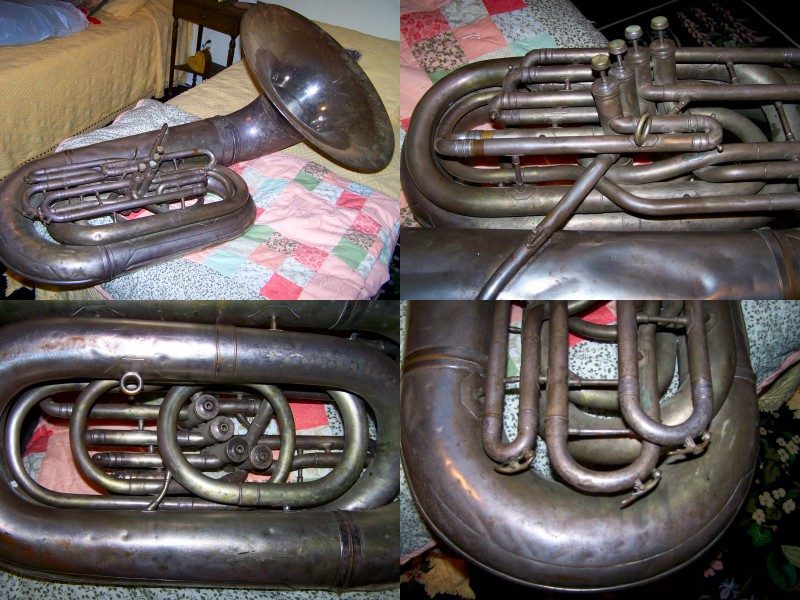
![Model TBD [SN 19534]. Photos used with permission from eBay Member: ford-c600.](https://contemporacorner.com/wp-content/uploads/2009/07/019534.jpg)
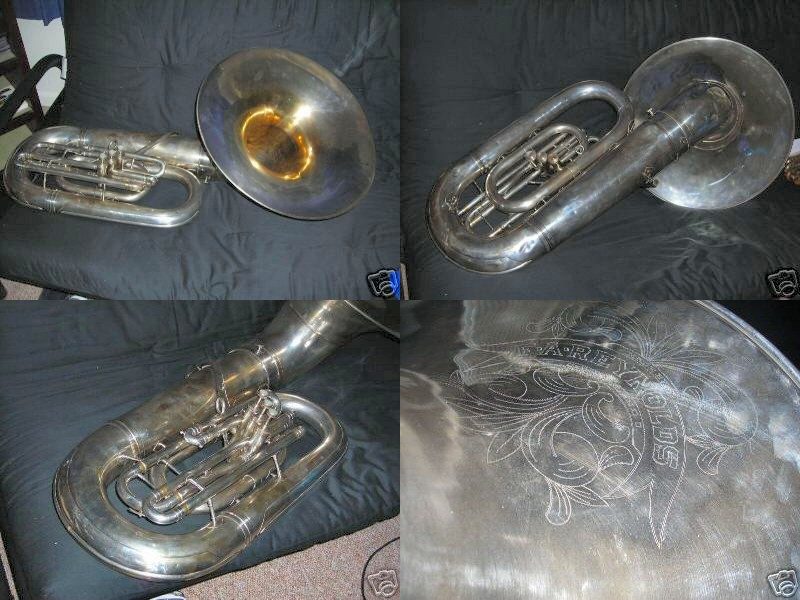
![Model TBD [SN 18138]. Photos used with permission from Dave Marinich (eBay Member: 2005marinich).](https://contemporacorner.com/wp-content/uploads/2009/07/018138.jpg)

